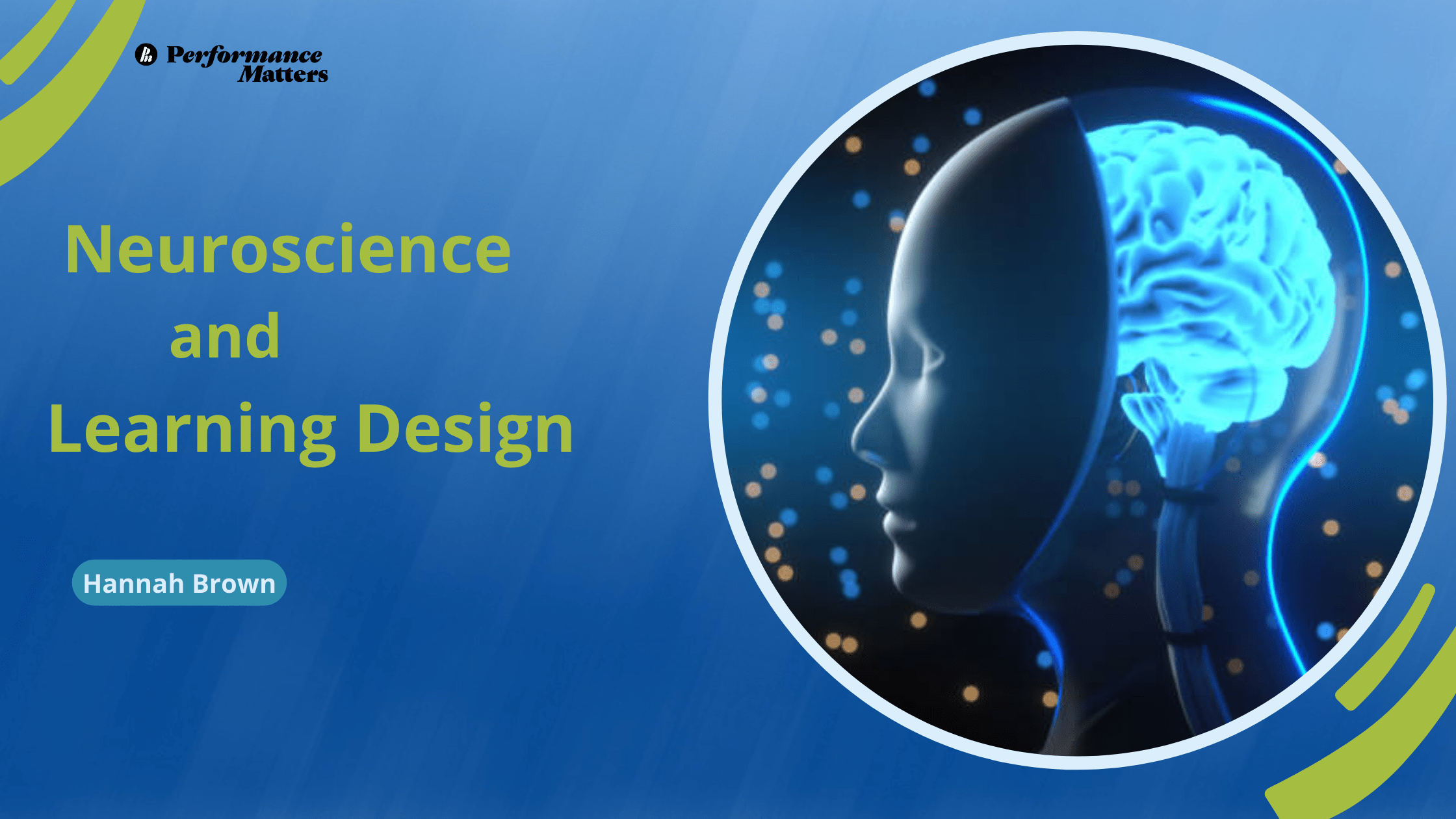Neuroscience is the study of the human brain and nervous system. Findings and insights from neuroscience can help us design training so participants are more likely to:
- Encode information into their long-term memory.
- Be able to retrieve it after.
Here are six tips from neuroscience research you can incorporate into your design to help your participants learn.
1. Writing by hand reinforces learning
I’m in a professional development networking group that meets virtually every month. Often the facilitator will ask us to get out a piece of paper and pen. Throughout the sessions, he asks us to draw shapes and arrows and fold our paper. I prefer taking notes digitally because it’s more organized for later and creates less clutter on my desk. Admittedly, I remember the sessions with folded paper much better though.
The Research
Associate professor Anne Mangen1 at the University of Stavanger’s Reading Centre was interested in whether or not our shift from analogue (books and handwriting) to digital (computer and keyboard) impacts the learning process. Reading and writing involve a number of senses, so feedback from our motor actions, together with the sensation of touching a pencil and paper provides feedback to our brains. This kind of feedback is significantly different from the feedback we receive when touching and typing on a keyboard. She found writing by hand strengthens the learning process. When typing on a keyboard, this process may be impaired.
Design implications
Encourage participants in your program to draw or write notes on paper as opposed to digitally. An in-between approach might be to invite participants to take notes or draw digitally using a tablet or pen if they have one.
2. Make it personal with a story to help learners engage with and learn the material.
The Research
Two psychologists, Greg Walton and Geoffrey Cohen did an experiment to identify the impact of having a personal connection on motivation. They invited students to complete a math puzzle. They were asked to read a report about a successful former math student. On the surface, the article was to provide background information. In reality, use the report to test their theory. Half the students read that the successful former math student shared their birthday. [They] “wanted to examine whether something as arbitrary as having a shared birthday with someone who was good at math would ignite a motivational response,” Walton said. After reading the report, the students were asked to solve the math puzzle.
The results were incredible. The motivation level of the students in the ‘shared birthday’ group soared.
- They persevered for 65% longer than the group who didn’t have a shared birthday.
- They reported significantly more positive attitudes towards math.
- They had greater optimism about their abilities.
Design implications
These researchers identified what could be called ‘motivation by association.’ By making the content more personal, students were more motivated. I’m not suggesting you identify all your participants’ birthdays, but you can make case studies or scenarios relatable. Give characters names. Make them diverse. Choose an industry or setting similar to your participants.’
3. Noise, whether it’s loud or in the background, is distracting and decreases learning.
I work from home and often like to switch up where I work. I have a few favourite coffee shops that I visit. Somehow having a change of ‘scenery’ helps me do different thinking and I’m able to focus better. Research shows, however, that being in coffee shops might not be the best way to learn.
The Research
These researchers2 studied the effects of noise on cognitive tasks. Forty participants completed different cognitive tasks to recall information. Participants were divided into four groups:
- “High arousal” (loud music)
- “Low arousal” (quiet music)
- Everyday noise
- Silence
Performance was less for all of the first three environments and “High arousal” generated the worse performance.
Design implications
My coffee shops would probably fall into the “Low arousal” or everyday noise categories. There seems to be a disconnect between my experience of being able to be more productive in a coffee shop and this study. I believe it’s the difference between learning something new and performing it as opposed to recalling existing knowledge and applying it. So, when your participants need to learn something new, provide a quiet space. Invite them to turn off their cameras to reflect on a concept, or put them into breakout rooms by themselves to read or practice.
4. Talking to yourself improves performance.
My family was driving to my in-laws’ for Easter weekend. It’s a three-hour drive and we had a late start so decided to get breakfast on the road. I told the kids to start thinking about what they wanted so they would be ready to order at the drive-thru window. My teenage son started listing off all the things we wanted to order. I said, “No, don’t tell me now. Just think about it and then say it out loud when we get there.” He responded with, “I need to talk out what I want.”
The Research
In this study3, researchers assessed the effectiveness of three different self-talk interventions on endurance performance. Participants were nine cyclists who performed a 20-minute cycling workout two times per week for five weeks. At each workout, they were asked to cycle as far as possible. After establishing a baseline, the cyclists were asked to do one of these self-talk approaches before cycling:
- Self-regulated positive self-talk (e.g., telling yourself, ‘I can do this.’)
- Assisted positive self-talk (e.g., someone else saying, ‘You can do this.’)
- Assisted negative self-talk (e.g., someone else saying, ‘You can’t do this’)
The results showed all cyclists’ performance improved with self-talk compared to their baselines. The greatest increase was with the assisted positive self-talk.
Design implications
My son wasn’t talking out loud to help him perform but talking out loud was helping him think. When designing training, create opportunities to encourage participants. You can do this as the facilitator, or you can enlist other participants. For example, if participants are completing a task or role-play, ask a partner to observe and provide constructive and positive feedback. Provide time for another practice of the skill so the participant can apply the feedback they received.
5. Learning from failure is more effective than learning from success.
The Research
There are two interesting research studies I want to highlight.
In the first4 experiment, participants completed a software training program. Half were taught to prevent errors from occurring, while the other half were guided into mistakes during training. The group that was encouraged to make errors not only exhibited greater feelings of self-efficacy but because they had learned to figure their own way out of mistakes, they were also far faster and more accurate in how they used the software later.
The second study5 examines learning from mistakes at an organizational level. The researchers examined what contributed to improved organizational performance:
- Learning from success.
- Learning from failure.
- Some combination of the two.
The researchers found that:
- Organizations learn more effectively from failures than successes.
- Knowledge from failure depreciates more slowly than knowledge from success.
- Prior experience and the magnitude of failure influence how effectively organizations can learn.
Design implications
Make learning engaging by making it challenging. Don’t give all the answers – allow participants to discover critical information. Clive Shepherd talks about a guided discovery approach in his book More Than Blended Learning: Designing world-class learning interventions. 6 This is where participants experiment and reflect on what they’ve learned. It’s an effective learning approach when participants have some prior knowledge or experience from which to draw upon. When incorporating planned failure for learning, make sure you have a robust debrief either as a large group, small group, or individually so participants can reflect on and learn from their mistakes.
6. Alternate where you learn to make learning more effective.
In High School, my husband took French and German in the same semester. The same teacher taught him, and he sat in the same room for both subjects. When he’d speak, he’d mix up French German and English words. No wonder, there was so much overlap between the languages!
The Research
Psychologists have discovered that some of the established advice on study habits is wrong. For example, the practice of teaching students in the same classroom is less effective than switching up the location.
In a classic 1978 experiment7, psychologists asked students to study a list of 40 vocabulary words. The students were all asked to study the words twice. Half the students remained in one room, while the other group studied the words in two different rooms. They found the students who studied in the two rooms did far better on a test than students who studied the words twice, in the same room. Later studies have confirmed the finding, for a variety of topics.
The brain makes subtle associations between what it is studying and the background sensations it has at the time. By the brain makes multiple associations with the same material, it’s encoding the information on different shelves in the long-term memory closet.
Design implications
With in-person training, we can hold training in different company buildings, or even off-site. within a building, we can use different rooms and multiple rooms for specific activities. However, with virtual training, participants join the sessions from their desks, which are the same location where they work. It might also be in the same location where they live. Participants have no location variety to help encode information. This may be one of the reasons people may prefer in-person training. As designers, we need to be extra vigilant with the other design tips and facilitation techniques to make our courses memorable and overcome this aspect of neuroscience and learning.
1 The University of Stavanger. "Better learning through handwriting." ScienceDaily. ScienceDaily, 24 January 2011. <www.sciencedaily.com/releases/2011/01/110119095458.htm> 2 Cassidy, G., & MacDonald, R. A. R. (2007). The effect of background music and background noise on the task performance of introverts and extraverts. Psychology of Music. https://doi.org/10.1177/0305735607076444 3 Ryan A. Hamilton, David Scott & Michael P. MacDougall (2007) Assessing the Effectiveness of Self-Talk Interventions on Endurance Performance, Journal of Applied Sport Psychology, 19:2, 226-239, DOI: 10.1080/10413200701230613 4 Cited in: The Happiness Advantage: The Seven Principles of Positive Psychology That Fuel Success and Performance at Work 5 Masden, Peter M., and Vinti Desai. “Failing to Learn? The Effects of Failure and Success on Organizational Learning in the Global Orbital Launch Vehicle Industry.” The Academy of Management Journal, vol. 53, no. 3, 2010, pp. 451–76, http://www.jstor.org/stable/25684332. Accessed 17 Apr. 2022. 6 "More than Blended Learning: Designing world-class learning interventions" (2015) Shepherd, Clive 7 Smith, S. M., Glenberg, A., & Bjork, R. A. (1978). Environmental context and human memory. Memory & Cognition, 6(4), 342-353.
In case you missed it
I’ve shared some additional posts online. Here they are in case you missed them.
- Visual design with instructional design – (link)
- Questions and answers about virtual training design – (link)
- Global trends impacting learning – (link)
- Cost distribution in e-learning – (link)
- Learning Strategy vs Curriculum Design – (link)



